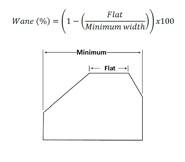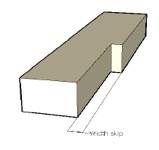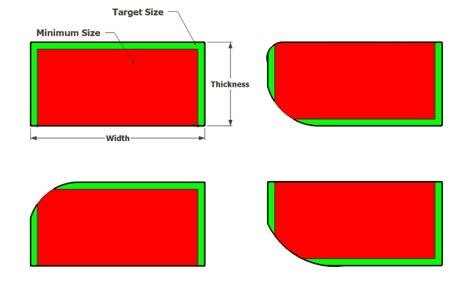Dimension and Grade Parameter Functionality of a Sawmill Transverse Board Optimizer
Posted on September 15, 2016
A sawmill trimmer and edger optimizer only knows what it’s been told. If we do not define a specific thickness, width or grade in the optimizer parameters, it will be unknown to the system and products will never be produced using these undefined attributes.
Since the product mix at a sawmill can become very complex, the optimizer’s ability to manage production is largely on the shoulders of the system users. The first step towards better management is an understanding of what the optimizer parameters actually do.
We will focus this discussion on the functionality of the thickness, width, wane and skip parameters.
Thickness/Width:
There are three values used for each Thickness/Width class:
1. Target:
- The dimension of the rough green product.
- For an edger optimizer, the Target is the actual dimension that will be sawn (i.e. If Target width is set at 5.75" then the optimizer will send saw positions to the control to saw exactly a 5.75" wide board).
2. Minimum:
- The minimum thickness/width accepted for a product.
- Wane and Skip are evaluated based on the minimum thickness/width dimensions.
3. Maximum:
- The maximum thickness/width accepted for a product.
Wane:
Wane is the lack of wood from any cause and is measured as a percentage of the face/edge for a specified length (Figure 1). Wane is evaluated on the Minimum dimensions NOT the rough green Target dimensions.

Figure 1. Illustration and calculation of wane, based on the Minimum dimension.
Skip:
Skip is the lack of wood across the face/edge in relation to the Minimum thickness/width (Figure 2). Skip is evaluated on the Minimum dimensions NOT the rough green Target dimensions.

Figure 2. Illustration of width skip, in relation to the Minimum dimension.
How can finished product grading rules be applied at the sawmill when the boards are rough and green?
The first step in the optimization process is to make a model of the rough green board. Then a secondary model called the “board within the board” is created within the rough green board’s model using the minimum dimensions set in the optimizer parameters. The positon of the “board within the board” is centered on the width and placed on the opposite side of the face wane for the thickness (Figure 3). The “board within the board” is then used to evaluate the acceptable amount of skip and wane based on the defined grading rules. Since we are ultimately concerned about the percentage of wane and skip at the planer mill, we need to set the minimum values high enough to account for shrinkage during the drying process and the amount of extra wood required for the planing process.

Figure 3: Illustration of the Minimum dimension in relation to the Target dimension for the optimization process of a sawmill transverse board optimizer.
Too much wane and skip being sent to the planer mill? Here are two things to check:
- Make sure the scanning accuracy is acceptable. If the model of the board is too far from reality then production will not be optimized properly (i.e. if the scanner is measuring the boards 0.25" too wide, then the optimizer would sort products that have too much wane/skip).
- Make sure the minimum thickness/width values in the optimizer parameters are not set too low and allow for shrinkage during drying and enough extra wood for planing.
Billy - Process Expert


